
Centre of Jaina Studies Newsletter: SOAS - University of London
The 12th Jaina Studies Workshop at SOAS on 18-19 March 2010, although only two days long, felt like a long journey through the history of Jainism. This year's theme was a very striking one: Jaina Yoga, a rare focus in Jaina Studies but highly interesting and long awaited. In spite of all the thorough research on yoga, the Jaina perspective has traditionally been ignored. This is not at all justified, as the conference showed.
The welcome blessings by the Śvetāmbara Samaṇīs Prasannaprajñā and Rohitaprajñā were planned to be shared with Svastiśrī Cārukīrti Paṇḍitācāryavarya Mahāsvāmījī, the Digambara Bhaṭṭāraka of Mūḍabidri, who was unfortunately not able to attend the entire program. His brief address and presence, in vibrant orange, as a moving spiritual kṣetra, on the second day of the conference was a highlight of the proceedings. The blessings were followed by the launch of the first English translation of Ludwig Alsdorf's classical study on The History of Vegetarianism and Cow-Veneration in India, and by the release of the inaugural volume of the Münchener Indologische Zeitschrift (MIZ) which especially welcomes contributions with Jainological contents. This was followed by brief speeches by the co-organizers of the conference: Christopher Chapple (Loyola Marymount University), Olle Qvarnström (University of Lund) and Peter Flügel (SOAS).
This year's keynote speaker was Professor Sagarmal Jain, the former Director of the Pārśvanātha Vidyāpīṭha in Varanasi who is now at the helm of the Prācya Vidyāpīṭha in Shajapura. About 200 people gathered in the Brunei Gallery Lecture Hall to listen to the 10th Annual Jaina Lecture at SOAS delivered by Professor Jain, who is equally known in Indian as well as in Western academic circles for his achievements in Jaina Studies. He gave a broad survey of the subject of the conference in his lecture on 'The Historical Development of the Jaina-Yoga System and the Impact of Other Indian Yoga Systems on It: A Comparative and Critical Study', which was a perfect entry into the subject.

J. C. Wright (SOAS)
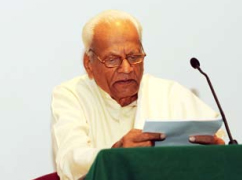
Sagarmal Jain delivered the 10th Annual Jaina Lecture.
Professor Jain distinguished five phases in the development of Jaina Yoga: the pre-canonical age beginning before the 6th century BCE; the canonical age from the 5th century BCE to the 5th century CE; the post-canonical age; the age of tantra and rituals from the 13th to 19th centuries, and finally examining the development right up to the present day, which he called the 'modern age'. He noted the interrelationships with other, parallel traditions of yoga in India and argued that Jainism and those other later traditions derived from an older common source, namely, the ancient śramaṇa tradition. In the course of time, the Jainas borrowed new methods, for instance, from Hindu and Buddhist Tantrism. This practice of open adaptation of useful techniques from other sources that are integrated into the Jaina practice is also seen in the latest developments, such as prekṣādhyāna, which is propagated by the Terāpanthī denomination of Jainism.
On the following day of the conference, Professor Olle Qvarnström from Lund University was the first speaker, followed by Bansidhar Bhatt from the University of Münster and two Terāpantha Samaṇīs based in London. The paper by Olle Qvarnström dealt with 'The Concept of Yoga in Jainism'. Qvarnström discussed the term 'yoga' and its semantic range within the tradition, or rather traditions, of Jainism, focussing mainly on Śvetāmbara texts and authors. In this way, Qvarnström helped the audience to gain an overview of the present state of research concerning the term 'yoga' in Jainism and also of the changes in the meaning of this term spanning centuries. His contribution was followed by Bansidhar Bhatt's paper entitled 'Study in the Meditational Techniques in Early Jainism', which concentrated on origins based on early textual evidence. Bhatt referred to the meaning of the term 'yoga' in Upaṇiṣadic times. In Jaina texts, he explained, 'yoga' can assume the meaning of 'undertaking something', it can be understood in a contemplative sense, or it can just mean 'in association with'. Along with yoga, Bhatt looked at terms like samādhi, dhyāna and tapas in Jaina texts, and he charmed the audience with his abundance of knowledge.
Unfortunately, although it had been announced in the programme, two Terāpanthī Samaṇī-nuns, Caityaprajñā and Rohiṇīprajñā from Jaina Viśva Bhāratī University in India, were unable to participate. Luckily the two London-based Samaṇīs Prasannaprajñā and Rohitaprajñā could take their places and kindly presented their paper on sandhi in Jainism, which according to the authors is to be understood as the spiritual praxis of Mahāvīra. While discussing the term and summarizing it as the aim of the spiritual aspirant, in which he can experience more sensitivity, the authors touched upon tantric ideas, defining marma as 'soul points' and cakra as a 'power station'. According to medicinal texts such as Suśrutasaṃhitā and Carakasaṃhitā, the organs of the body occupy several condensed soul points. Sandhi understood as points in the psychic (taijasa) body with more karmic permeability is already described in canonical texts (Ācārāṅga). The late Ācārya Mahāprajña, an important teacher in their tradition, redefined sandhi as 'psychic point' and in that way revived the spiritual praxis of sandhi in our modern times.
A short coffee break prepared the participants for a further highlight of the conference, papers given by John E. Cort from Denison University, USA, and Johannes Bronkhorst from the University of Lausanne, Switzerland. One of few participants to do so, John Cort dealt with Digambara Jainism when speaking on 'When will I meet a Guru? Images of the Yogī in Digambara Hymns'. Cort explored the literary trope of the ideal yogi, also called muni or sādhu, in the Digambara context. This image of the ideal mendicant first appeared circa 500 CE in two texts called Yogibhakti, written by Pūjyapāda in Sanskrit and by Kundakunda in Prakrit, respectively, according to the traditional ascription. The vision of a perfect ascetic is also widely found in medieval Apabhraṃśa literature, such as in the works of Yogīndu, and also in Hindi padas from the time between the 17th and 19th centuries (poets such as Dyānatraya, Bhūdharadāsa, Jagrāma Godikā, Budhajana, Bhāgacanda and Daulatrāma). Cort's thesis is that these literary images of the ideal yogī kept the concept of the perfect muni alive even in times of less practical ascetic activity in the Digambara religion and helped to bring about the revival of nudity for monks in the 12th century. He emphasized that these poems must have been literary projections rather than descriptions of reality, as Digambara munis were virtually nonexistent in the north of India during that time. Johannes Bronkhorst presented the audience with a more philosophical subject. His research was on Kundakunda's concept of the true nature of the self, which he discussed in his paper 'Kundakunda versus Sāṃkhya on the Soul'. Bronkhorst argued that Kundakunda (re)introduced the idea of the immovable soul (puruṣa) as described in the Sāṃkhyakārikās into the Jaina discourse of the time, but not without modifying the original concept to adapt it to his own religious tradition. In that way the notion of the self in Jainism changed under the influence of Kundakunda's modifications.
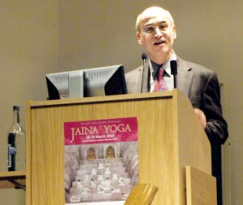
Christopher Key Chapple (Loyola Marymount University)

Bhāṭṭāraka Cārukīrti
The afternoon session began with a paper on 'The Jaina Yogas of Haribhadra' by Christopher Key Chapple, one of the organizers, from Loyola Marymount University, USA. He proceeded on the basis of his earlier studies of Haribhadra's literature, such as Haribhadra Yākinī Putra from the 8th century, and focused on the concept of the fivefold yoga of Haribhadra Virahāṅka from the 6th century, found in a text titled Yogabindu. This text describes an elaborate system of yogic practice including introspection (adhyātma), cultivation (bhāvanā), meditation (dhyāna) and so on, which the speaker also discussed in the light of Umāsvāti's traditional analysis of the fourteen guṇasthānas.
'Yaśovijaya's view of Yoga' by Jeffery D. Long from Elizabethtown College, USA, explored the perspective on yoga as held by the 17th-century Śvetāmbara author Yaśovijaya. Yaśovijaya had discussed his view of yoga in contrast to the views of other religious communities. Long argued that Yaśovijaya should be seen as a philosopher who stands between the so-called classical and modern periods. His 'modernity' showed in ideas such as accepting yogic experience (anubhava) as a valid source of authentic knowledge about liberation. Long discussed in detail Yaśovijaya's point of view in comparison with Kundakunda, Haribhadra and Śaṅkara, and showed that Yaśovijaya even used the Bhagavadgītā and Brahmanical terminology to defend his ideas.
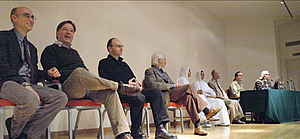
Piotr Balcerowicz, from the University of Warsaw, spoke about 'Extrasensory Perception in Jainism: Its Proofs and Soteriological Implications'. According to Balcerowicz, the concepts of yogipratyakṣa (extrasensory perception) and sarvajñatva (omniscience) were most prominently correlated in Jainism, even if other Indian religious traditions such as Buddhism and NyāyaVaiśeṣika did the same, in a less obvious way, from the 6th century onwards. He examined the doctrinal and philosophical reasons behind this and discussed the soteriological implications, mainly based on the idea that extrasensory perception and the knowledge gained as a result are necessary steps on the Jaina path towards salvation.

The last session of the day started with a paper by Smita Kothari, a PhD Candidate from the Centre for South Asian Studies at the University of Toronto, as the previous speaker in the programme, Andrea R. Jain from Rice University, USA, was, at the last moment, unfortunately unable to come to London. This was also the case with Jayandra Soni from the University of Marburg whose paper 'Yoga in the Tattvārthasūtra' was read in his regrettable absence by Jens Borgland of the University of Oslo. Smita Kothari spoke on 'Dāna and Dhyāna in Jaina Yoga'. She questioned whether or not charity (dāna) is a necessary precursor to meditation (dhyāna), which is a significant issue as dhyāna is one of the most important methods on the path of liberation. If so then dāna provides an attractive means by which Jaina lay people can ascend the ladder to salvation. Kothari explained the institutionalization of dāna in the Jaina Śrāvakācāras and its broader implications for the lay community, with writings of the main founders of the Śvetāmbara Terāpanthī community, such as the Ācāryas Bhikṣu, Tulasī and Mahāprajña, as textual bases.
The final discussion, for which all the scholars assembled on the stage, was chaired by Robert Zydenbos of the University of Munich. Most of this discussion was between Jaina lay people in the audience and the scholars who had presented talks in the course of the day. The discussion was lively and obviously of great interest to the audience, and we hope that this will be a regular feature of future conferences.
As a general observation it can be said that this conference, attended by many Jaina lay people and students, showed that there is a very strong interest in Jainism as a subject of scholarly investigation. The conference, especially during periods of public discussion, permitted a mixed discourse between academic researchers and religious adherents. Many of the papers pointed to further avenues of inquiry for scholars of Jainism. This is not only true for the earliest history of Jainism. The medieval period lies as much in darkness as nearly the whole of the cultural history of Digambara Jainism, as well as its vast literature and diverse ideologies, which are unique within Jainism and remain understudied, in spite of some remarkable exceptions. And another thing became apparent: We can only get a clear picture of Jainism through the ages, be it the earliest time of Śramaṇas or Jainism today, when we all work together and share our research results on a regular basis. The presence of a huge lay community and questions from the audience evinced that there is a deep desire for more research on Jainism and public engagement, that there is a growing interest in learning more about this extremely old and still vibrant religion. This SOAS Centre of Jaina Studies workshop succeeded in the difficult task of combining academic research and open discussion with the interested Jaina lay audience, and also in finding a middle way by giving a voice to valuable primary sources from India and members of the Jaina community itself, and the extrinsic perspective of scientific discourse on the other hand.
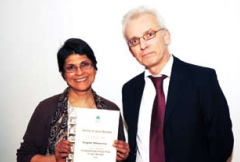
Shruti Malde, MA SOAS 2010, accepts the CoJS 2009 Undergraduate Essay Prize on behalf of Brigita Molnarova from Robert Lightfoot, N.K. Sethia Foundation & IOJ London.
On the whole this conference was an academically as well as socially enlightening experience, made so not only by virtue of the stimulating papers and their knowledgeable authors, but also by the contribution of the host of the Jaina Studies Workshops at SOAS, Peter Flügel, who did not forget to give the workshop a finishing touch with delightful coffee breaks and Indian cuisine that was suitable for vegetarians, a service which not many international conferences can offer. We are happily looking forward to the 2011 SOAS Centre of Jaina Studies workshop, Jaina Narratives, which is sure to offer further insights into Jainism and its cultural impact on India and the rest of the world.
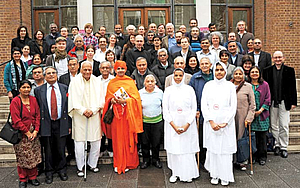
Eva-Maria Glasbrenner studied philosophy, Indology and religious studies at the University of Munich and Sanskrit at the University of Pune, India. She is now a PhD student at the University of Munich, where she teaches Sanskrit, Indian philosophy and religion. Her publications include "The Gommaṭeśvara's Grand Mahāmastakābhiṣeka Ritual: Aisthetics of Religion as a new Method of Research of Jaina Ritual". In: Nalini Balbir (Ed.), SVASTI. Essays in Honour of Prof. Hampa Nagarajaiah for his 75th Birthday. K.S. Muddappa Smaraka Trust: Krishnapuradoddi/Bangalore 2010, pp. 332-345).
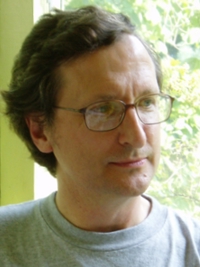 Prof. Dr. John Cort
Prof. Dr. John Cort